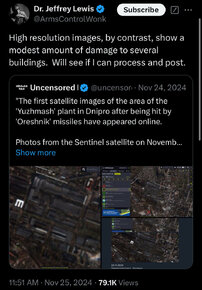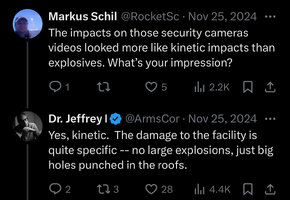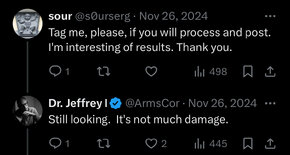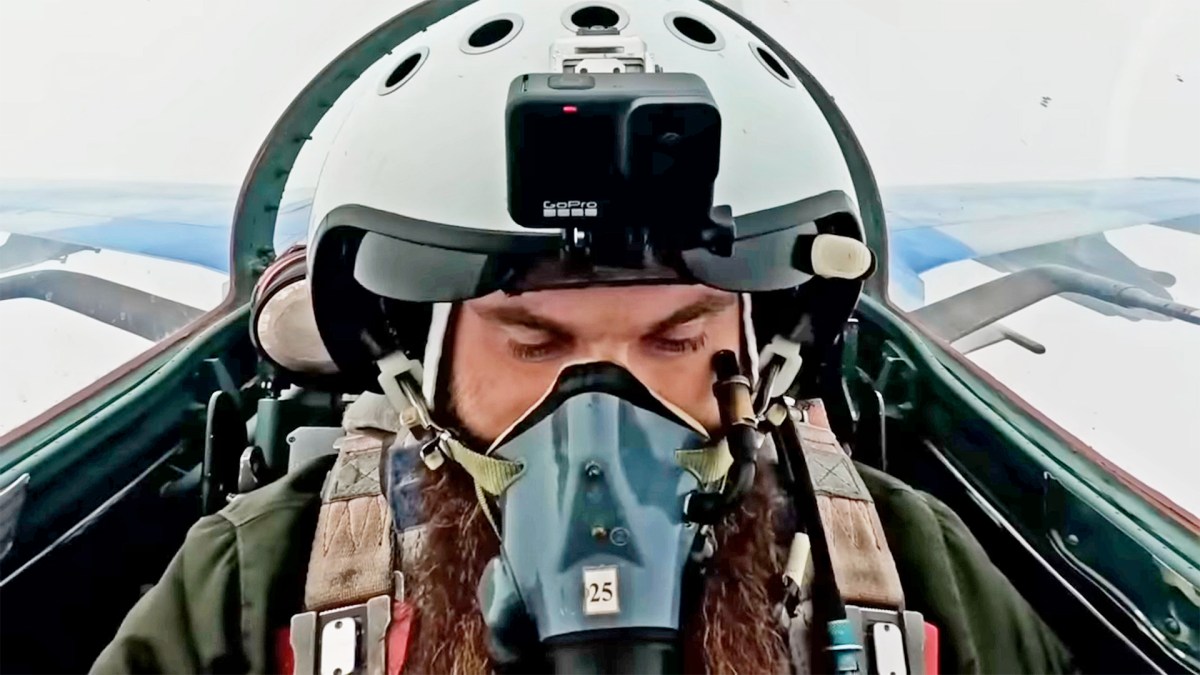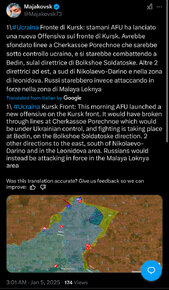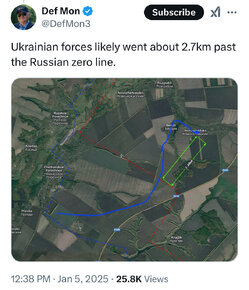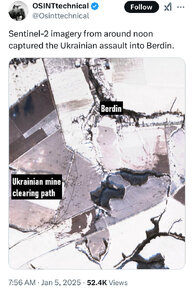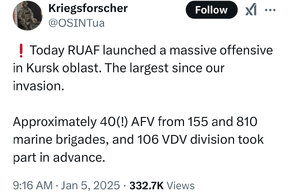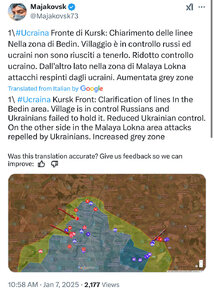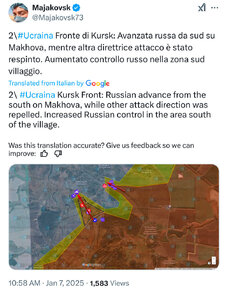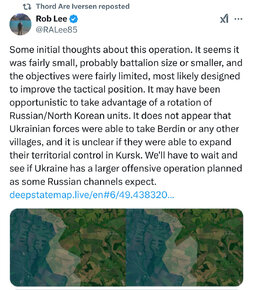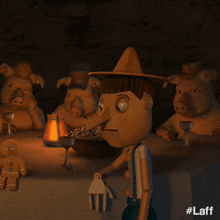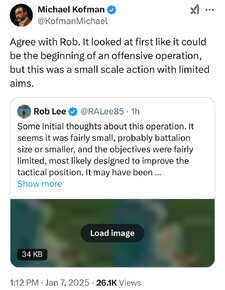All the damage he got in the images he ordered was present in images pre-strike. In other words no new visible damage appeared. At least that's his claim. I didn't purchase satellite imagery myself. So it's not that damage was minor, it's that it literally wasn't there at all. I agree that the damage might be limited, but it would still be nice to see what that "limited damage" is.
I see what you mean now. I now read both of the articles you cited as well. Not sure what to say about it though. For example, the author didn’t find some of the existing damage on the “post-strike” image he purchased first until he looked at the much clearer one he purchased later, the one from October, I believe. Since on the structures like those (mostly) present on the territory of the plant we would likely be looking for holes in the roofs and craters on the ground, I don't know what the diameter of those holes would be as I have no idea what diameter of the munitions Oreshnik carries is, so maybe someone more savvy on the subject can chime in; but I can't imagine those holes to be overly large. Hence, I don’t think it is wrong to assume that such damage would be pretty hard to find on the image he presented. The collapsed 3-5-story buildings the author highlighted in his first article make very little sense, along with the entire roofs entirely collapsed and so on. I would expect that most of the damage from a kinetic strike like that would be hidden from a satellite eye and found on the floors way below, if not in the basement, while to the outside observer the building would appear to be structurally sound or completely untouched. Whatever “blanks” the munitions were loaded with would probably melt through the roof and several floors of a “regular” structure. I am no expert on the subject though and just speculating here based on the very basic knowledge. The same could be true even with the conventional loads, I would think (more speculation).
His assertion about Google meddling with their images (and projecting it to Maxar as well) in order to conceal the damage, I am 100% confident is wrong. Ok, 99.9% confident, ha! I would wager that what he is (and we are) looking at Google Maps at (and this is easily verifiable on Google Earth, but I do not have a laptop handy, just the phone) when we are looking at Dnipro or many other areas of Ukraine is likely at least half a decade old stuff. These places have little relevance to Alphabet or Apple and the like so their maps update very rarely for those areas and almost randomly - that is, they can get a block updated, while the surrounding areas would still be 5+ years old and it could remain this way for years. This also true for the “boonies” here in Canada or the US, etc. My own previous house location took over 8 years to be updated after the date I purchased it, for example. Again, this true for any large landmass that has little meaning for the users of their services. I know this from my personal experience (both as a regular user of these maps, provided where I live and spend my outdoor leisure time, and as a professional user of the same and many other maps in my student years - the latter was relatively long time ago and things may have changed since, but I did some side work in GIS for the government, which never materialized as a career, and I know this can be a big issue).
As for Maxar, the source where the author purchased his imagery from, and others the like, I very much doubt they modify what they sell. It is simpy bad for business and reputation would be the easiest explanation. Surely, a rando on the internet who wants to witness the damage to some plant in Ukraine for himself is very far from their main clientele, but the fact remains. There would certainly be some kind of disclaimer about it (and maybe there is?) or, more likely, some specific images wouldn’t be available for purchase for some specific length of time to a rando on the internet. I just don’t see it happening, the modifications I mean.
Another example from real (though still virtual) life and that is related to this war specifically. There are people who have access to some specific satellite imagery on the Ukrainian strikes on the Russian assets (and vice versa), who comment on it and often provide imagery, or little chunks of it. Yet, sometimes they comment on what they see, but at the same time they state that they do not have permission to release the (bits of) images out into the wild for various reasons. Sometimes those reasons are purely common sense business oriented, sometimes it is “security” related, and so on. But for a company to sell or otherwise provide an image supposedly taken on some certain date and provide something else instead isn’t realistic, in my opinion. I mean it could happen, but is highly unlikely.
I think in this particular case it could be as simple as the actual damage is not something he was looking for. In other words, he is looking for damage, but that damage looks entirely different from what he expected and he simply didn’t see it or it is not easily visible on the imagery he had purchased. You can see in the author’s first article his predisposed mind finding specific things, drawing lines of groups of strikes (cassettes, as he called them), examining them, and providing his opinion. Perhaps, a person with a trained eye and experience would eliminate most of what the author had found as an improbable footprint provided the little knowledge they had about the strike. The author, on the other hand, found exactly what he was looking for, even though that was not what had actually happened. And, to his benefit, he admitted just that and wrote another article. Not to his benefit, in his second article, he made more unreasonable, in my opinion, assumptions about Google meddling with the maps just so that the war damage could be concealed, though the latest damage that he himself found was from July of 2024, less than or about 6 months from the time of his publication, and the earliest was from fairly early 2022, which is quite a spread of a timeline to be meddling with on the constant basis, especially in some irrelevant location such as Dnipro, Ukraine (the logical thing (and sound business decision), if that were the goal/case, would be to leave these areas without an update completely until “better times”).
It was cool to read nonetheless, both articles. And that is for various reasons. For example, one is that it greatly, in my opinion, illustrates that sometimes you find exactly what you are looking for, and this is actually quite a bit of a problem with this current conflict and the observers: a whole bunch of people observing and posting their analysis, a whole bunch more reading and reposting it and so on. This is all in addition to the most intense disinformation campaigns by the official parties involved in the war. I do applaud the author for admitting his mistake and writing another article about it, accusations towards Google notwithstanding (he can’t help his bias as there is got to be something going on! and that is fine). Second, these articles shed light in one place, so to speak, about the cumulative damage that the plant has sustained over the almost three years of war (mostly from the intercepted debris, I am sure). And so on.
And as for actual damage caused by the Oreshnik strike, no one here
can tell anything for sure. I think that the fact that the plant was hit is undeniable since this was reported by the Russians, Ukrainians, Americans, you name it. All said that Yzhmash was hit by the strike. I saw one or two reports that I am not willing to look for at the moment that something else civilian was hit half and a kilometre away or something like that - the evidence was, I remember, not very convincing due to the the extent of the damage, parts of the Oreshnik missile falling within the vicinity, and other missiles striking targets in the area around the same time. Whatever Jeffrey Lewis was looking at, who I cited above, seems to line up with my personal expectations (my own bias noted) and I have no reason not to trust his opinion on the subject. It would be nice if he posted the sample images of the holes that he saw, alas… I wonder if he was looking at the same image as the author of the articles or something else.
Side note, the author of the articles wondered if he was allowed to post the images publicly like he did; I am fairly certain he is not. But good for us, haha.
Unrelated to the above and without much commenting from me - more of an information sharing type of thing:
A good article based on the interview with a Ukrainian Su-27 pilot:
The rare interview details combat operations over Ukraine, including the employment of Western guided munitions from Su-27 Flankers.

www.twz.com
An interesting thread on X (readable to everyone) on the subject of the Azerbaijan liner incident. I am not vouching for or refuting the validity of the information presented.
@ChrisO_wiki: 1/ Russian air defence crews reportedly shot down Azerbaijan Airlines Flight 8243 with two missiles fired from a Pantsir launcher near Grozny, after being 'blinded' by a Russian electronic warfare syst...…

threadreaderapp.com
An excellent read from Tatarigami on the internal issues within the Ukrainian forces and beyond:
No any particular source at the moment (take as hearsay), but the recent reports I saw suggest that the intensity of strikes with glide bombs may be coming back.
Probably out of space in this post by now, so won’t post anything else.



